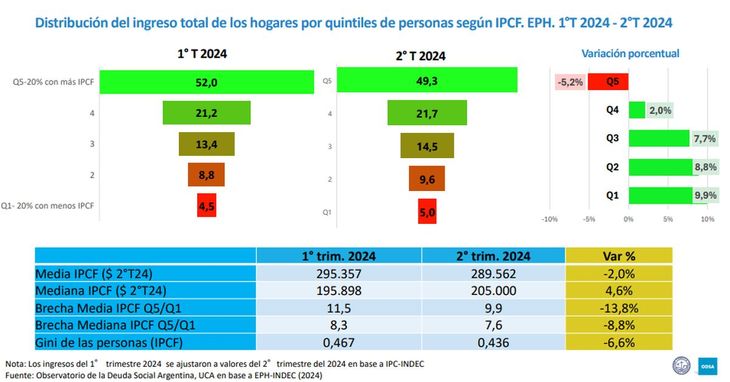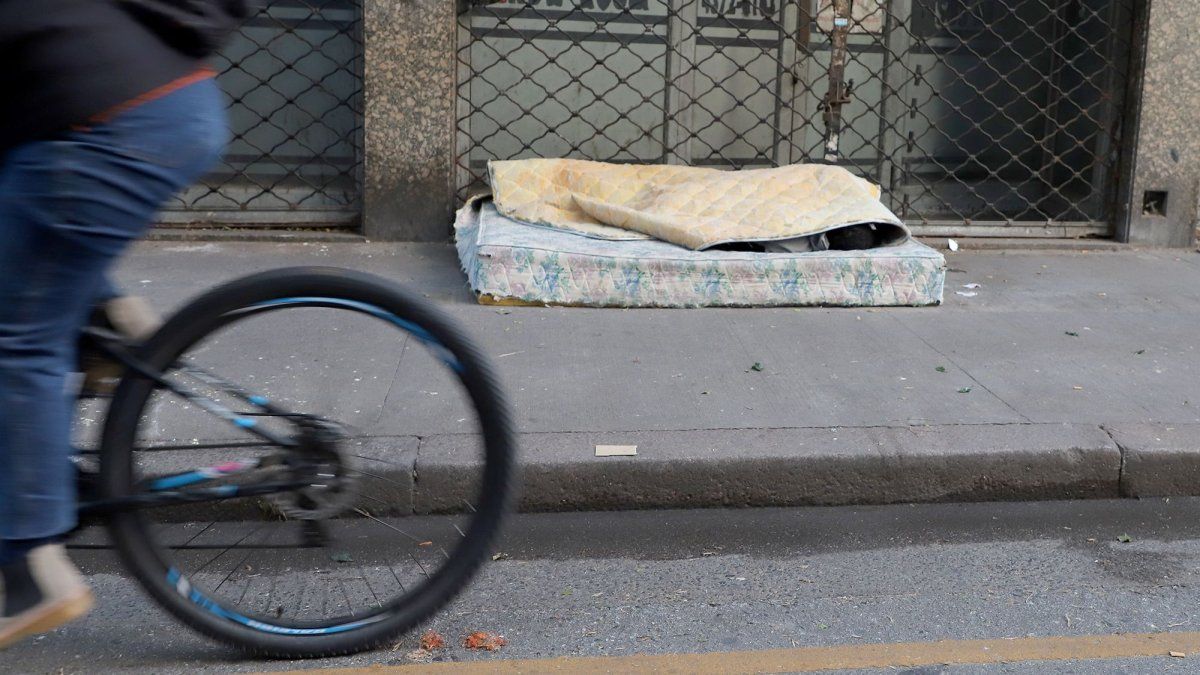Shortly after completing the first 12 months of the management of Javier Milei, the recession has a strong impact on the population, inflation It does not stop and salaries barely manage to recover the drop of recent months. From the second quarter of 2023, the purchasing power of wages fell 11% and it widened inequality due to a greater income concentration in the hands of the richest sectors.
A report of Argentine Social Debt Observatory of the Argentine Catholic University called “Changes in well-being and income distribution” warns that among the second quarter of 2023 and the same period of 2024 was evidenced impoverishment of the population due to three factors: the “loss of consumption capacity in a high inflation scenario”, the absence of improvements in income and the “accelerated increase in prices.”
The deterioration in income affected all social strata, but, according to the survey, It affected the most vulnerable sectors to a greater extent. “The lowest stratum was the one that had to face a more significant drop in its purchasing power. In this way, the income gap in the lowest strata with respect to the baseline widened. indigence and poverty”, measured based on the basic and total food basket.
uca poverty inequality report.jpg
The increase in unemployment to 7.6% in the second quarter further deepened the impact on the most vulnerable sectors. Currently, more than 1.7 million Argentines suffer job loss. That, added to the few opportunities to compensate for the fall in real income Through “informal self-employment”, it directly affected the economic quality of society.
“The period 2023-2024 is thus characterized by a deterioration in well-being, but differentiated within the social structure,” the report continues and adds: “Everyone loses, but the lower strata lose more in absolute and relative terms. “This gives rise to a profound decline in economic well-being and a more regressive distribution of income.”.
Furthermore, the authors point out that there was a decrease in real terms in the volume of income of households that comes from the labor market, as well as in non-labor monetary resources. “Structural inequalities remain in relation to the composition of the income of domestic units: lower strata with greater dependence on non-labor income and a greater share of labor income among households in higher strata,” they explain.
Falling incomes and rising inequality
If the survey is disaggregated among the employed, the income loss is greater among those who receive lower labor incomecompared to those who make up the upper echelons of the population, according to the analysis carried out by Agustín Salvia, Julieta Vera, Rodrigo Jara and Miranda Correa of the ODSA-UCA.
The drop in the population’s income reached 12% on average: in constant values, It went from $330,658 in 2023 to $289,562 in 2024. The variation “was insufficient” to compensate for the increase in the basic food and non-food basket, which is why “a loss of real income was generated” among Argentines.
The drop in income was more significant in the lowest stratum. For this reason, specialists noticed a growth in levels of inequality. “This is reflected in a increase in the index of Gini inequalityas well as a slight increase in income gaps between extreme quintiles,” they explained. Last week, INDEC reported that the Gini coefficient grew from 0.417 to the 0.436 in the second quarter.
To graph the shift in the economic pyramid, the report indicates that during the second quarter of 2024, The 20% of the lowest-income population appropriates only 5% of the total monetary resources. While the 20% with the highest incomes account for 49.3%.
In the midst of the economic recession, the appropriation capacity of those employed at the top of the pyramid grew from 44.9% to 48.3% of the total volume of income. On the contrary, the index of those who receive lower income decreased from 4.3% to 3.5%. “In this period, the income gaps of the main occupation (Q5/Q1) increased,” they indicate.
Slight recovery in income, but uneven
Despite the notable drop in income compared to 2023, it is not all bad news. The report ensures that the quarterly comparison of the first period of 2024 with the second shows, on the one hand, “a slowdown in the rate of increase in the price of goods and services” and, on the other, “a slight recovery in real income”mainly in the lower strata.
The purchasing capacity of real average income from main occupation increased by 7%. This is because the greatest growth in prices occurred in December and January, when inflation reached peaks of 25.5% and 20.6%, respectively. Meanwhile, during the second quarter, the increase moderated, although it did not stop growing.
uca inequality report recovery.jpg

In any case, they are still far from returning to last year’s levels. So what was lost has not yet been recovered. “Unlike what was recorded in the year-on-year comparison, the most disadvantaged sectors were those that exhibited higher levels of recovery in economic well-being, between the 1st and 2nd quarter of 2024. This in a framework in which they had previously faced significant losses in their purchasing capacity,” they point out.
With a small recovery, the average income registered in the lowest sectors of the pyramid “would have been slightly closer to the basic food and non-food requirements necessary for subsistence”. Such improvement was “uneven”, they indicate from the UCA. It was observed mainly in the middle strata, while the lows “do not show recovery” so the distribution registered “greater concentration” among the employed in the middle of the pyramid.
As a result, the report observes “a decline of income inequality levels in the comparison between successive quarters”. However, since ODSA-UCA They clarify that the comparison is between a first quarter with a bonus and a second quarter without a bonus, so “it is expected that the quarters with a bonus will register higher levels of inequality.”
To explain the slight recovery, the report points to the external income sources to the labor market. “This happens even more intensely in households in the 1st quintile”that is, those with the lowest resources, in which non-labor income “shows greater recovery.” The income share outside the labor market showed an increase in the budget of households in the lowest stratum.
Source: Ambito
David William is a talented author who has made a name for himself in the world of writing. He is a professional author who writes on a wide range of topics, from general interest to opinion news. David is currently working as a writer at 24 hours worlds where he brings his unique perspective and in-depth research to his articles, making them both informative and engaging.




